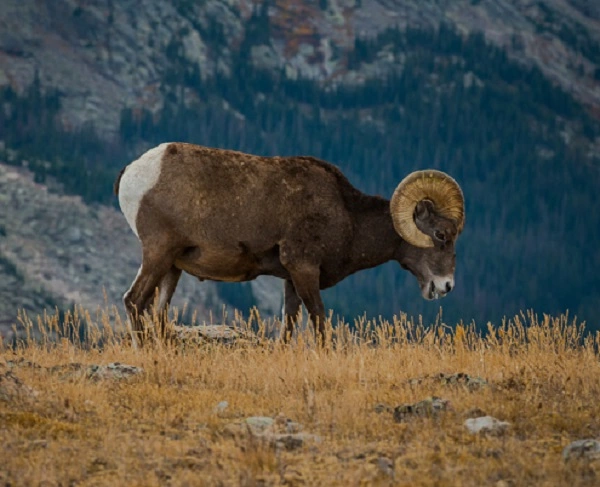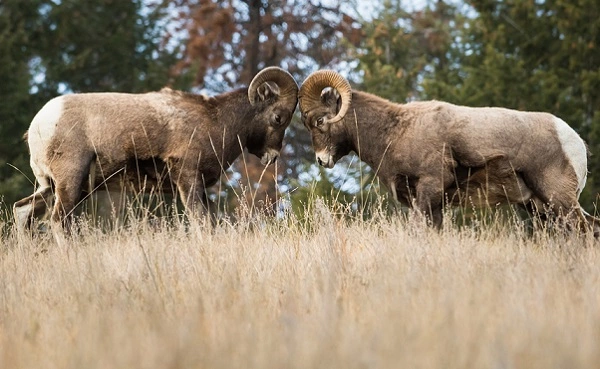Are you curious about bighorn sheep? This post will teach you all about these interesting animals, from their size and diet to their behavior and lifespan. Bighorn sheep are fascinating creatures, and I hope you’ll enjoy learning more about them!

Bighorn Sheep Description
Bighorn sheep are a species of wild sheep that are native to North America. They get their name from their large horns, which can grow up to three feet in length. Bighorn sheep are herbivores and primarily eat grasses and shrubs. They live in mountainous regions and can be found in the Rockies, Sierra Nevada, and Cascade Range. Bighorn sheep are social animals and live in herds of 10-20 individuals. The herd is led by a dominant male, known as a ram. Rams compete for dominance through head-butting contests. Bighorn sheep have thick fur that helps to keep them warm in cold temperatures. They are also good climbers and can scale steep cliffs with ease. Bighorn sheep are an important species in North American ecosystems and play a vital role in the ecology of the mountain West.
Bighorn Sheep Habitat
Bighorn sheep are a species of ungulate that are native to North America. The animals are best known for their large horns, which can grow up to two feet in length. Bighorn sheep inhabit a variety of habitats, including mountains, grasslands, and deserts. The animals are well-adapted to living in harsh conditions and can endure extreme temperatures. Bighorn sheep are herbivores and primarily eat grasses and other plants. The animals play an important role in their ecosystems by helping to disperse seeds and control vegetation growth. Bighorn sheep are also a popular target for hunters and are prized for their horns and meat. In recent years, the species has come under threat due to habitat loss and fragmentation. As a result, bighorn sheep populations have declined in some areas. Conservation efforts are underway to help protect the species and ensure its long-term survival.
Bighorn Sheep Diet
Bighorn sheep are native to North America and can be found in the Rocky Mountains and Great Basin region. Their diet consists mostly of grasses and sedges, with some shrubs and herbs. Bighorn sheep will also eat lichens and mosses, which they consume during the winter months when other food sources are scarce. Bighorn sheep are browsers, meaning that they feed on a variety of different plants. This allows them to adapt to different habitats and find food even in times of drought. Bighorn sheep play an important role in the ecosystems they inhabit, and their diet helps to support a variety of other wildlife.

Bighorn Sheep Size
Bighorn sheep are a type of ungulate, or hoofed mammal, that is found in North America. The bighorn sheep is one of the largest species in the family Bovidae, which includes antelope, buffalo, and cattle. Adult bighorn sheep weigh between 90 and 280 pounds, with males being larger than females. Males also have larger horns than females, which can grow up to three feet in length. Bighorn sheep are herbivores, and their diet consists mostly of grasses and shrubs. The bighorn sheep is an important species in North America, and its population is currently stable. however, the species is threatened by habitat loss and fragmentation, as well as by introduced diseases.
Bighorn Sheep Lifespan
Bighorn sheep are a species of sheep that is native to North America. They get their name from their large horns, which can grow up to two feet in length. Bighorn sheep are known for their agility and strength, and they are often seen climbing steep cliffs and hillsides.
Bighorn sheep have a lifespan of 10-12 years in the wild. However, they have been known to live up to 20 years in captivity. Bighorn sheep are predators, and their main diet consists of grasses and other plants. They also eat small mammals, such as mice and rabbits. Bighorn sheep typically live in herds of 10-20 individuals. During the winter months, these herds will migrate to lower elevations in search of food.
Bighorn Sheep Behavior
Bighorn sheep are a type of ungulate, or hoofed mammal, that is native to North America. These animals are best known for their large horns, which can grow up to 30 inches in length. Bighorn sheep are generally found in mountainous regions and can climb to heights of 14,000 feet. These animals are herbivorous and primarily eat grasses and sedges. Bighorn sheep are social animals and live in herds of 10-20 individuals. The herds are led by a single male, known as a ram, and typically consist of females and their young. Bighorn sheep are generally shy and aloof around humans. However, they have been known to approach people in search of food. Bighorn sheep are an important part of the North American ecosystem and play a vital role in the balance of the food chain.
Bighorn Sheep Speed
Bighorn sheep are one of the fastest animals in North America. They can run up to 30 miles per hour and jump up to 6 feet high. Bighorn sheep are also excellent climbers. They often climb steep cliffs to escape predators or to get to new grazing areas. Bighorn sheep are very agile and have good balance. This allows them to move quickly and safely over rough terrain. Bighorn sheep are well-adapted to their environment and are able to live in a variety of habitats, from desert plains to cold mountain slopes.
Bighorn Sheep Hunting
Bighorn sheep are a type of wild sheep that is indigenous to North America. They get their name from their large, curved horns, which can grow up to two feet in length. Bighorn sheep are hunted for their meat and horns, which are used in traditional Native American ceremonies. The hunting of bighorn sheep is regulated by state and federal laws. In order to hunt bighorn sheep, hunters must obtain a permit from the appropriate authorities. Bighorn sheep are generally found in mountainous regions. They are shy and elusive animals, which makes them difficult to hunt. Bighorn sheep hunting is a challenging and rewarding experience for those who are willing to put in the time and effort.
Conclusion
Whether you’re a wildlife enthusiast or simply looking for an interesting animal to learn about, bighorn sheep are definitely worth taking the time to get to know. With their unique adaptations and fascinating social structures, these animals are sure to capture your attention. If you want to see bighorn sheep in person, there are plenty of places throughout North America where they can be found. So get out there and start exploring! Have you ever seen a bighorn sheep in the wild?
Frequently Asked Question

